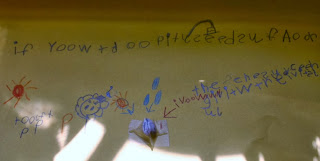We are sure you have heard your child talking about their Super Reading Powers. You may be wondering what they really are and how do they help your child read? We have made a short video of a child reading a new level A text for the first time. When your child has a new book the first thing they need to do is picture walk the book. A picture walk is just looking closely at the illustrations on each page and talking about what words they can expect to see. We did not video that part for the purposes of time. What is on the video is the first read through of a level A book. Level A books have a pattern. All of the words repeat on each page EXCEPT for the last word on each page. The children will memorize the pattern and the book, and that is wonderful. This is the first step to conventional reading. What is important at this stage of reading development is that they are looking at the pictures for visual cues to help them decode new (tricky) words. In level A books this is the last word in the sentence. The reader needs to be pointing at each word tapping once under each word as they read it. This strategy helps them learn that each group of letters forms a word, and each word has a meaning. Many times, if they are not pointing, they will make up extra words. We call this using our Super Reading Finger. The reader learns that each tap means one word, and if they are adding extra words there is nothing to tap under. We do not slide our finger under each word. The pointing/tapping is very important. Most students will stop pointing when they become more confident as readers. This usually happens around level D or E. Even strong readers may return to pointing when they are trying to decode/read a very difficult passage. The students are also learning to use their Eagle Eye. This means looking closely at the illustrations to try to figure out a tricky word. Most of the words on the page are our "popcorn" or sight words. This is why spending time helping them learn these words are so critically important. Popcorn words are words that usually cannot be sounded out and words that are common in most passages a young reader will see in the text. The students need to be able to read/identify these words very quickly so they can move forward in the passage they are reading. Another Super Power we are introducing soon is Lips the Fish or your Super Reading Mouth. This strategy teaches the reader to look at the first letter of a tricky/unknown word and make the first sound to help them figure out the word. This, along with using their Eagle Eye (using the illustration) can help the reader figure out a new/unknown word.
We thought it would be helpful for you to see what it looks like when a reader is using these strategies to read a new Level A book. We hope you find this helpful. The more times a child reads a book the more fluid (reading like you are talking) they will become. The more times they see the words while pointing to them and reading them, the more familiar the symbols (the groups of letters that make up the word) becomes to them. This helps them identify the words in a new book they might read and transfer that knowledge (such as the word pond, fish and splash in this video) when they see it in another book. Young readers learn through imitation (listening to and trying to sound like a fluid reader which is why we ask you to read to them 20 minutes a day) and repletion (reading the same book over, and over, and over again). Thank you for taking the time to help your child become a strong and confident reader and a life long lover of books. Enjoy the video. We hope it helps you when you are working with them in their reading bags and other books at home.
We thought it would be helpful for you to see what it looks like when a reader is using these strategies to read a new Level A book. We hope you find this helpful. The more times a child reads a book the more fluid (reading like you are talking) they will become. The more times they see the words while pointing to them and reading them, the more familiar the symbols (the groups of letters that make up the word) becomes to them. This helps them identify the words in a new book they might read and transfer that knowledge (such as the word pond, fish and splash in this video) when they see it in another book. Young readers learn through imitation (listening to and trying to sound like a fluid reader which is why we ask you to read to them 20 minutes a day) and repletion (reading the same book over, and over, and over again). Thank you for taking the time to help your child become a strong and confident reader and a life long lover of books. Enjoy the video. We hope it helps you when you are working with them in their reading bags and other books at home.

























































